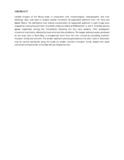| dc.contributor.author | Brakel, Willem H. | |
| dc.date.accessioned | 2014-07-16T07:26:46Z | |
| dc.date.available | 2014-07-16T07:26:46Z | |
| dc.date.issued | 1984 | |
| dc.identifier.citation | Brakel, W. H. (1984). Seasonal dynamics of suspended-sediment plumes from the Tana and Sabaki Rivers, Kenya: Analysis of landsat imagery. Remote Sensing of Environment, 16(2), 165-173. | en_US |
| dc.identifier.uri | http://www.sciencedirect.com/science/article/pii/0034425784900609 | |
| dc.identifier.uri | http://hdl.handle.net/11295/73097 | |
| dc.description.abstract | Landsat imagery of the Kenya coast, in conjunction with meteorological, oceanographic, and river discharge data, was used to analyze coastal movement of suspended sediment from the Tana and Sabaki Rivers. The distribution and relative concentration of suspended sediment in each image were mapped by tracing the perimeter of turbidity features visible at MSS bands 6, 5, and 4. Turbidity plumes appear seasonally, during and immediately following the two rainy seasons. Their subsequent movement is primarily, affected by local wind and tide conditions. The largest sediment pulse, produced by the long rains in April–May, is transported north from the river mouths by prevailing southern monsoon winds and currents. The smaller sediment plumes generated by the short rains in November may be carried southward along the coast by weaker northern monsoon winds, despite the usual continued northward flow of the East African Coastal Current. | en_US |
| dc.language.iso | en | en_US |
| dc.publisher | University of Nairobi | en_US |
| dc.title | Seasonal dynamics of suspended-sediment plumes from the Tana and Sabaki Rivers, Kenya: Analysis of landsat imagery | en_US |
| dc.type | Article | en_US |
| dc.type.material | en | en_US |

